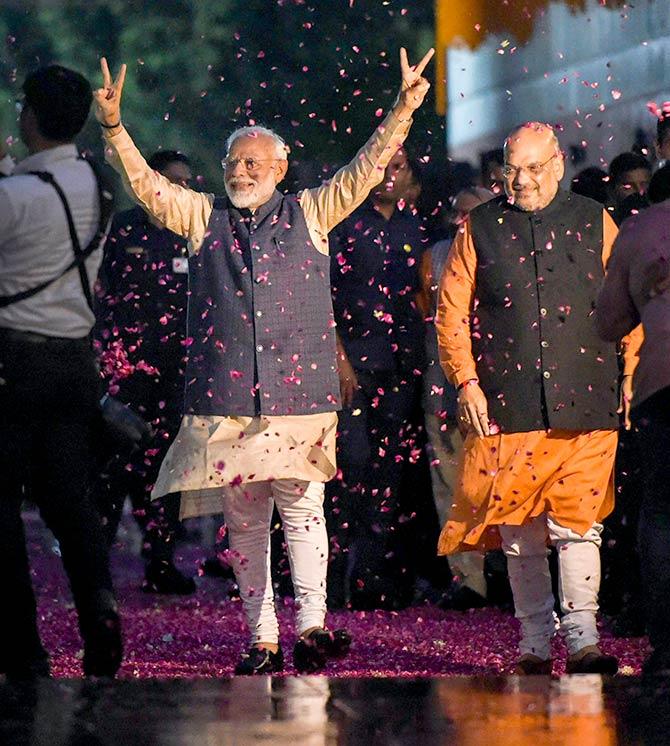Modi garners nearly 37% vote nationally, courtesy West Bengal, Odisha, Karnataka and Telangana.
Abhishek Waghmare reports.

In an unprecedented electoral performance, the Bharatiya Janata Party has shed its image as a force limited to the Hindi heartland and western states, and made massive inroads into the east and the south.
Apart from the near-clean sweeps in its core regions, the BJP crossed a tally of 300 seats fully owing to its advances in West Bengal, Odisha and Telangana, and consolidation of its stronghold in Karnataka.
This ensured a resounding majority win for the BJP, balancing out the losses from the Mahagathbandhan in Uttar Pradesh.
While the BJP lost 11 seats in UP, it gained 34 seats in the four states mentioned, courtesy an efficient conversion of vote share to seats in these states.
Nationally, the BJP has garnered over 37% of votes in the country in the 2019 polls, adding 6% to the 31% share it amassed in 2014.
This performance is nearly comparable with that of Indira Gandhi in the 1967-1980 period, when the Congress's vote share hovered between 40% and 43%.
According to provisional data, the Congress has garnered about 20% votes, marginally higher than the 19.5% it earned in 2014. Its seat tally remained at 51.
The BJP more than doubled its voter base in Bengal, from 17% in 2014, to nearly 40% of the state voting for the saffron party in 2019. This helped the BJP increase its seat tally from 2 to 18 (including leads at the time of going to press).
This poses a serious threat to the political ambitions of Mamata Banerjee, the two-time chief minister.
In a saving grace, the Trinamool Congress too improved its vote share from 40% to 44%. This reduced the damage to the party, though it lost over 10 seats.
Both the TMC and the BJP gained vote share by severely denting the support base of the Left. The vote share of the Communist Party of India-Marxist plummeted from 23% in 2014, to less than 7% this time. The BJP ate away half of the Congress's base, too.
In Odisha too, the BJP is now standing neck-and-neck against the Biju Janata Dal. The BJP's vote share in the eastern tribal state jumped from 22% to 38%.
In comparison, the BJD's vote share dropped 2 percentage points, but remained strong at about 42%.
As a result, the Modi-led BJP poached 7 seats from the BJD, and increased its tally to 8.
The Congress, which got 26% votes in the 2014 Lok Sabha election in Odisha, reduced its influence to nearly 14%.
Patnaik had earned 20 seats in Parliament for his party in 2014, which reduced to 13 this election.
The BJP had emerged as the single largest party in the Karnataka assembly election in 2018, with 36% votes and 104 seats in the 224 seat assembly, falling marginally short of a majority.
In 2019, it has now garnered more than 50% vote share in the southern state, winning 23 of the 28 seats.
Here, the BJP severely dented the support base of the Congress, whose vote share dropped significantly from 41% in 2014 to 32%.
As a result, the Congress faced its biggest defeat in Karnataka. The feeble Opposition party lost 7 seats, retaining just 2 in a state where it is in power, in coalition with the Janata Dal-Secular. The JD-S remained a silent spectator, with a trample damage of losing one seat.
The absence of the Telugu Desam Party from the contest in Telangana threw up a surprising result. All three parties -- the BJP, the Congress and the Telangana Rashtra Samithi -- improved its vote share. But the Congress and the BJP expended its effort in select seats, winning 4 seats each.
The BJP nearly doubled its vote share, becoming a formidable saffron force in a second south Indian state. Though the TRS won a landslide in the assembly election six months ago, it lost three seats in the Lok Sabha election, reducing its tally to 8.
In the heartland, the BJP consolidated its voter base. Its vote share in UP rose 10% from its 2014 performance. Now, nearly 50% of UP's electorate favours the BJP. This performance comes after the ruling party lost successive bypolls in the state in the last two years.
In Rajasthan and Madhya Pradesh, the BJP had lost the assembly elections six months ago. Springing back from defeat, the BJP touched a vote share of 60% in the two states, losing only 2 seats in these.












 © 2025
© 2025